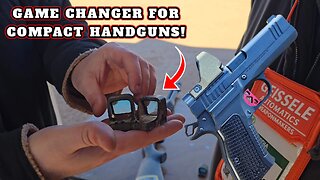Premium Only Content

Homemade Electric Buggy Range Test
Hi folks! In this video I take the electric buggy for another drive to test the range of the 14 kWh battery. If you haven't seen it yet, you can check out the full build video here:
https://youtu.be/xBl3KHxCyQI
I covered a good variety of terrain from asphalt to loose rock, at high and low speed (& power) while averaging somewhere between 60-70 km/h. I think that's typical for most off road drivers, at least the ones that I ride with, and should give you a good idea of what can be expected if you were to build or convert your own buggy.
I had my dad following me around in his truck in case I had any trouble, but I didn't want to take up too much of his time so I only drained around 59% of the battery during this test, which provided 49 km of range. The discharge curve for li-iron phosphate is so flat that we can estimate the total range per charge to be around 80 km, which is 10 km more than the max range from the Polaris Ranger XP Kinetic's premium 14.9kWh li-ion battery at a slower 50 km/h. The Polaris has a slightly lower range because it's 300 lbs heavier and a 4x4. I could nearly double the range for my buggy w/ li-ion cells instead of li-iron phosphate because they're almost twice as energy dense, which means they pack twice as much energy capacity into the same amount of space. But the trade-off is that li-ion is far less stable than li-iron phosphate - the former is the type that you hear about on the local news after a Tesla catches fire. I chose LFP specifically to avoid this in the event of a crash or a short. They're far safer to use, especially in this application where I'm surrounded by the battery and strapped into a 5-point harness with no doors. LFP also lasts up to 3000 cycles or more, whereas li-ion will only last around 300 cycles.
That being said, I think li-ion would be the better choice for something like a side by side that's easier to get in and out of and requires more range. I normally don't drive anymore than 80-90km off road in a day with my atv, but I know some people who travel 2-3 times more in their 4x4's. That's why Polaris has a 29.8 kWh battery available for the XP too, which should deliver around 160 km's per charge.
My buggy, however, probably won't see the public trails again after this video. It's better suited for a dirt track for a number of reasons. The obvious being the 80 km range - it's fine for light trail driving, but it's more than sufficient to spend a day competing in a few 5-10 lap rallycross races or time trials on a typical 2 km track. There are no rallycross tracks in my area though. Not yet anyway. Thankfully I have 40 acres of land of my own to play on, but it needs some work to convert the narrow atv trails into a proper track.
SPECS
Power: 24 kW continuous, 55 kWp for 60 sec (72 hp)
Motor: ME1616 brushless IPM 3 phase AC
Max torque (at motor shaft): 134 nm (99 ft-lb)
ESC: Kelly KLS-8080N-NPS, programmable
Transmission/gearing: chain driven LSD w/ 5:1 gearing
Battery: 102V, 14 kWh LiFePO4
Charging: 1 hour charge @ 1C max
Range: 80-100 km on mixed terrain @ 60 km/h
Cooling: Active air and liquid
Regenerative braking
Electronic forward and reverse
Weight: 465 kg (1027 lb)
Wheelbase: 203cm (80")
Track: 160cm (63")
Ground clearance: 178mm (7")
Website: https://www.resystech.com
Follow RST on Facebook:
https://www.facebook.com/RenewableSystemsTechnology
-
 1:41:00
1:41:00
Darkhorse Podcast
6 hours agoIf Only We’d Known: The 265th Evolutionary Lens with Bret Weinstein and Heather Heying
64K29 -
 LIVE
LIVE
Conspiracy Pilled
3 days agoThe Vaccine Conversation (S5 - Ep17)
306 watching -
 11:22
11:22
Tundra Tactical
3 hours agoUSA vs Canada HOCKEY Fight: The Real PRIDE Fighting.
12K -
 54:43
54:43
LFA TV
1 day agoWhy Exposing Waste and Fraud Terrifies the Beltway | TRUMPET DAILY 2.19.25 7PM
8.23K1 -
 1:01:13
1:01:13
Candace Show Podcast
5 hours agoBlake Lively's BOMBSHELL Legal Filing | Candace Ep 149
79.1K105 -
 1:11:22
1:11:22
Vigilant News Network
8 hours agoElon Musk Shuts Down RFK Jr. Critics With One Powerful Statement | The Daily Dose
54K22 -
 1:12:23
1:12:23
Dad Dojo Podcast
20 hours ago $0.47 earnedEP20: The Super Bowl and Solving The Economy
23.3K -
 4:49
4:49
Tactical Advisor
3 days agoBest Small Handgun Optics | CH PWS Shot Show 2025
16.5K2 -
 1:01:21
1:01:21
In The Litter Box w/ Jewels & Catturd
1 day agoI've Got Your Proof - Right Here! | In the Litter Box w/ Jewels & Catturd – Ep. 745 – 2/19/2025
94.9K31 -
 2:14:30
2:14:30
FreshandFit
8 hours agoDavid Icke On COVID Lies, Censorship, Secret Societies, Infiltration of MAGA, AI Control, Alternative Media Subversion And MORE!
94.4K51